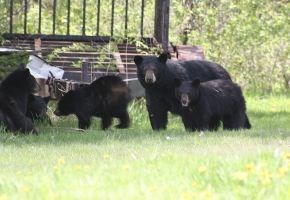Each spring, well-meaning people find juvenile animals that they believe are abandoned and rescue them.
Many are brought to Wild at Heart Wildlife Refuge Centre. Wild at Heart would like the public to understand when wild animals require human intervention and when they don't.
Like humans, juvenile animals thrive best with their parents and should not be removed from the wild unless there is evidence that the parent is deceased, or the animal is injured or sick. If in doubt, please consult Wild at Heart Wildlife Refuge Centre before attempting to remove an animal from its habitat.
Do not attempt to rehabilitate the wild animal on your own. Each animal has nutritional and care needs that are highly specific to its species. Also, it is illegal to keep wildlife in your home.
For more information, visit wahrefugecentre.org.
Dealing with local wildlife:
Snowshoe hares leave their babies on their own during the day. Before commencing yard work, take a look around to see if rabbits, or any other species, have taken up residence. The babies often scatter when disturbed. It is best to leave the area intact so that the baby hares can return to await the parent. Do not intervene unless there is a dead parent nearby. The mother will return at night to care for her babies.
Fawns are born scentless, so deer leave them alone for most of the day to avoid leading predators to the fawn, and only return to feed the fawn for short periods of time. It is best to leave the fawn where you found it unless you are sure that the mother has been killed, the baby is wandering around alone for an extended time, or is injured or obviously sick.
Cats should be kept indoors. Many species of wild birds are especially vulnerable in June and July. The domestic cat is not a natural predator of wild birds, and cats are a serious problem for songbirds whose numbers are already at historic lows - mainly due to habitat loss, pollution, pesticides and other human impacts. Fledgling birds will soon be hopping around on the ground for days at a time while learning to fly. Rest assured, the parent is nearby and feeding the young bird.
These are the most commonly "kidnapped" animals, as people expect birds to fly. If a nest is blown or knocked out of a tree, it can be placed back into a tree. If the nest has been destroyed, pre-fledgling birds can be put in a hanging basket (with drain holes) such as a margarine container, and hung on a nearby tree to allow the parent to continue to feed and care for the youngster. It is not true that the parent will abandon the young bird if it was touched by humans - most birds don't have a good sense of smell.
In our area, raccoons give birth to their young in the spring and summer months, and they often nest in sheds and other buildings. At this time of year, people regularly, and often unknowingly, orphan baby raccoons when they relocate the parent. If a raccoon nest is discovered, if possible, it is best to wait a few weeks until the young are old enough to leave the nest. If you must remove the nest, leave the young raccoons in a box near the original nest. The mother will retrieve them herself. As a general rule, relocation is not a long-term solution, as another animal of the same species will take up residence in the territory.
Wild at Heart Wildlife Refuge Centre is a non-profit organization and a registered charity that provides veterinary treatment and rehabilitation to wild animals that are orphaned, sick, or injured, so that they may be returned to the wild. Wild at Heart also acts as a resource to the public to help find and promote humane solutions to conflicts with wild animals.
For more information, call 692-4478, or visit Wild at Heart's website wahrefugecentre.org.
